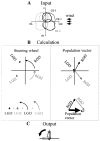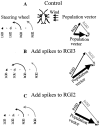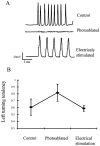Population vector coding by the giant interneurons of the cockroach
- PMID: 10804222
- PMCID: PMC6772708
- DOI: 10.1523/JNEUROSCI.20-10-03822.2000
Population vector coding by the giant interneurons of the cockroach
Abstract
We tested two alternative models of integration among the cockroach giant interneurons (GIs) for determining the directions of wind-evoked escape turns. One model, called steering wheel, pits contralateral GIs against one another; the other, called population vector model, involves a vector computation among the GIs. In testing each model theoretically, the population vector was found to account far better for the actual behavior. Both models could account for the results of previous behavioral-physiological experiments in which spikes had been added to the right GI3 together with wind stimuli from the right side. The two models revealed a critical behavioral-physiological experimental test that we then performed; namely, when delivering wind from the right side, adding spikes experimentally to the right GI2 should increase turn size according to the steering wheel model but should decrease turn size according to the population vector model. The latter result was obtained. The population vector, but not the steering wheel, model also could account for previous behavioral-physiological experiments in which spikes were added experimentally to a GI contralateral to the wind stimuli. The results support the population vector model as accounting for direction determination among the cockroach GIs.
Figures








References
-
- Abeles M, Gerstein G. Detecting spatiotemporal firing patterns among simultaneously recorded single neuron. J Neurophysiol. 1988;60:909–924. - PubMed
-
- Camhi JM. Escape behavior in the cockroach: distributed neural processing. Experientia. 1988;44:401–408. - PubMed
-
- Camhi JM, Levy A. Organization of a complex movement: fixed and variable components of the cockroach escape behavior. J Comp Physiol [A] 1988;163:317–328. - PubMed
-
- Camhi JM, Tom W. The escape behavior of the cockroach Periplaneta americana. I. Turning response to wind puffs. J Comp Physiol [A] 1978;128:193–201.
-
- Comer C. Analyzing cockroach escape behavior with lesions of individual giant interneurons. Brain Res. 1985;335:342–346. - PubMed
Publication types
MeSH terms
LinkOut - more resources
Full Text Sources
